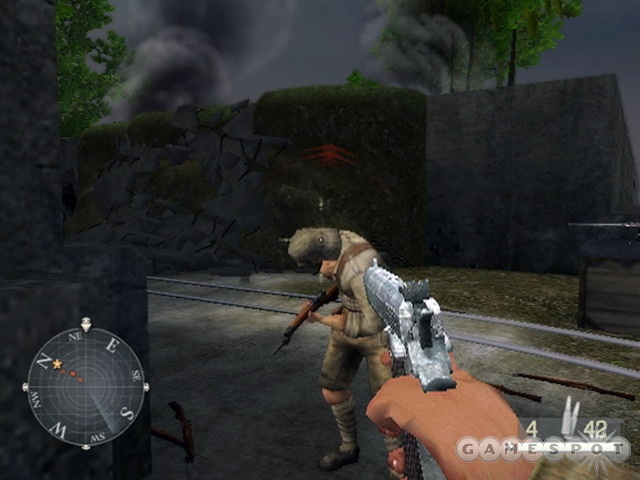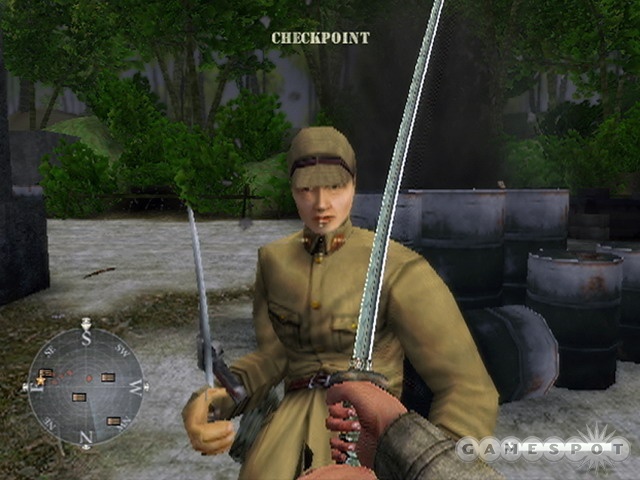Unlike the Xbox 360 version of Battle for the Pacific, the PlayStation 2 release showed some promise. Rather than following around a brain-dead soldier on a series of stand-alone missions, you actually play out a real story in some interesting jungle environments. The problem with Battle for the Pacific isn't in the design, but in the execution. Dumb artificial intelligence, tedious action, and god-awful visuals get in the way of the game's potential and keep this war from being worth fighting.
There's a little bit of narrative here to tie things together. As Jonathan Farrell, you'll fight Japanese soldiers across 12 missions, most of which take place in jungle environments. Scrolling text and a competent voice-over fill you in on your objectives, and occasionally, a yawn-inducing History Channel segment will pop up to give you some historical perspective on the proceedings. None of it's very good--for example, there are weird grammar errors in the script, which makes you wonder if the actor playing Farrell ever thought to mention anything--but it glues things together enough to keep you playing through the three-hour campaign.
The first thing you'll notice about Battle for the Pacific is that it's incredibly ugly. The game drowns you in a mess of muddy greens and browns, and textures are so blurry and unsightly that it's hard to make out anything from a distance. Yet for some reason, the game performs horribly (though surprisingly better than on the Wii), with the frame rate dipping noticeably when there is dense foliage on the screen. When the action cuts away for an in-engine cutscene, the whole thing becomes a nausea-inducing slide show. Additionally, like in the other versions, there is an effect that blurs your view when you reload your weapon, though in this case it obscures things to the point that you can make out absolutely nothing in the distance. All of this gets in the way of the gameplay, considering that you'll often be under attack by enemies that you simply can't see.
Like the Wii version, the artificial intelligence is guilty of some obvious cheating. It's noticeable less prevalent here, though; instead you will deal with a lot more enemies at any given time. This makes the PS2 version more entertaining than the others because you can actually see past the flaws in execution and get a feel for the game itself. Battle for the Pacific still can't rise above mediocrity, though; the levels are far too straightforward, and your foes are far too dumb and predictable, which makes the action get monotonous after a while.
It's too bad that these problems are so obvious, because there are moments when you realize that had it been executed better, Battle for the Pacific could have been a much better game. You'll take down camouflaged soldiers hiding in trees, find alternate routes and secret ammo stashes, and hear your foes shout in Japanese. The missions are linear, to be sure, but there's enough freedom of movement to take cover behind rocks, flank your foes, or hide in buildings and take potshots through windows. There are even instances where the music and sound effects can get your blood pumping a bit. Standard stuff to be sure, but there are brief moments of entertainment amid the ugliness.

Although the game is functionally the same as the Wii version, the shooting mechanics have been improved. The controls are still a bit off, and moving either analog stick usually results in a less subtle action than the one you were planning on, so you shouldn't expect to aim with the kind of precision you're used to in other shooters. Nevertheless, the controls are passable, and you can aim using iron sights quite successfully this time around. This makes the game much more enjoyable, given that you'll be taking on a good number of foes, with tighter (though still imperfect) controls. However, enemy soldiers are just as moronic as in the other version; they often don't react to being shot, and they sometimes run up to you to perform a melee attack for no apparent reason.
There are no multiplayer options, so unless you want to go back and gun for faster mission completion, find more hidden objectives, or earn better shooting accuracy, you're done when the end credits roll. It's too bad that some major issues had to get in the way, because this game could have been an interesting way of brushing up on your World War II history. In reality, you'd be better off taking night classes and leaving this history lesson buried in the bargain bin.
